I tried 6 popular running apps—and this is the best one
18 miles later, I picked my favorite app.
Products are chosen independently by our editors. Purchases made through our links may earn us a commission.
Back in high school, I was an avid runner. You could find me out there nearly every day in rain, snow, or shine, running multiple miles and even getting a couple of half marathons under my belt. Looking back on it, I was kind of crazy. Nowadays, I can’t even imagine running when it’s colder than 50 degrees, let alone going for more than a few miles.
But now that it’s finally spring, I’ve decided to hit the pavement, throw on my favorite sneakers and wireless headphones, and try to get into this whole running thing again. One of my favorite ways to do this is by tracking my data. I don't need to get too scientific, but I do get motivated by seeing my mile splits get lower over time or watching my mileage climb because it’s physical proof that I’m improving.
The easiest way to track your runs is with the help of a running app. They can track your run path, mile splits, and elevation, and even have special features like running plans and playlists. There are a lot of running apps out there with many associated with brands like Nike, Asics, and Under Armour. Each one works slightly differently, and it can be overwhelming to choose which one is best. So, I decided to test the six most popular running apps using the same 3-mile loop to figure out my favorite, and boy, my legs are tired.
1. The winner: Runkeeper
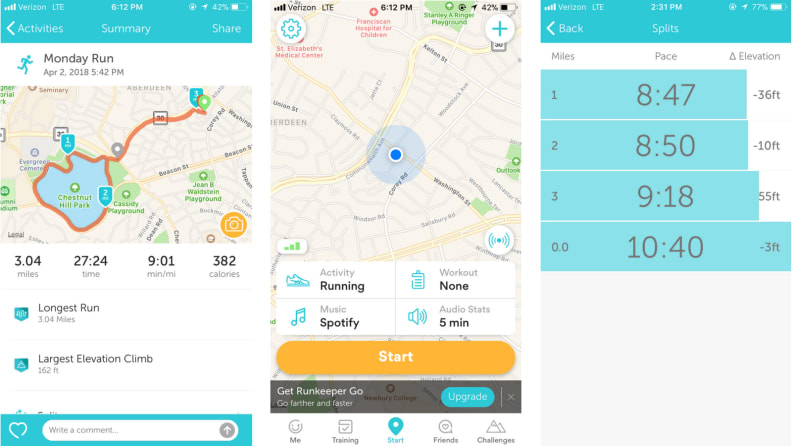
Screenshots of my Runkeeper run.
My favorite feature: Gorgeous interface and clear running stats.
I fell in love just looking at the design of Runkeeper. It has a lovely light blue color scheme, fun fonts, and an easy-to-navigate interface that made me think running was going to be fun. Runkeeper is owned by Asics, and as an avid Asics shoe owner, it added to the appeal of the app.
This app was my favorite by far because of not just its look, but also how customizable it is. When I went to start my run, I was able to choose which activity I was doing (there’s even a stopwatch mode), what audio stats I wanted, and how often I wanted to hear them. I could also connect my music through Spotify or Apple Music. Once I completed my run, the app gave me basic stats like distance, time, pace, and calories burned as well as a breakdown of my splits for each mile. The app also showed me my pace, elevation, and steps taken in fancy graphs.
One of the things I enjoyed most was that I immediately got achievements after my first run for longest run and highest elevation, which is already encouraging me to beat them. You can also get deeper insights (for those intense trainers) and training plans for exercise or races by purchasing Runkeeper Go ($9.99/month, $39.99/year).
2. Runner-up: Nike+ Run Club
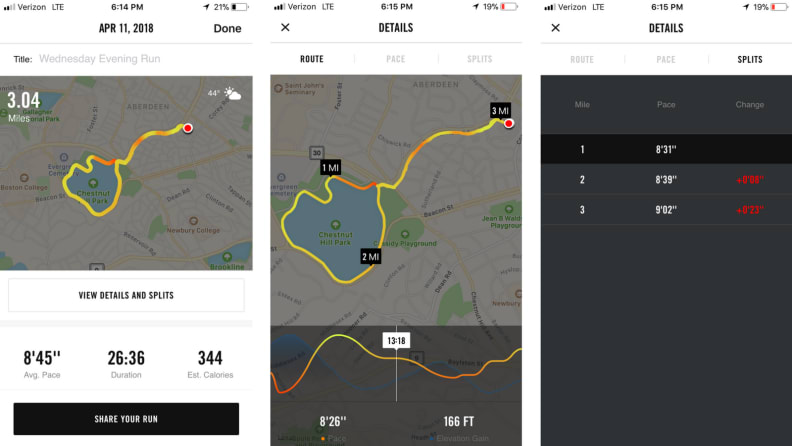
Screenshots of my Nike+ Run Club run.
My favorite feature: It's free!
Before trying out all these other apps, Nike+ Run Club used to be my go-to running companion. When I first started running, I exclusively used Nike sneakers (until I had a terrible experience with shin splints), so I figured I would use a Nike app as well. Now I have years of data tracked on it, which is interesting and inspiring to look over.
The #1 thing this app has going for it is that it’s completely free. Unlike other apps on the list, the Nike app allows you to set up training plans, challenges, and guided runs, which also goes hand-in-hand with their Nike Training app, at no extra cost. But unlike the apps you do have to pay for, there’s no option to get more advanced or in-depth stats.
The look of this app is electric and powerful—much like the Nike brand. It tracks your basic stats, gives you the most achievements to earn, and has fun color levels to strive for. Arguably, the coolest feature is that each run ends with a motivational cheer from a celebrity or pro athlete. My biggest complaint, however, is that the music tends to be softer to make up for the audio stats, so I have to turn my headphone volume higher to compensate.
3. Map My Run
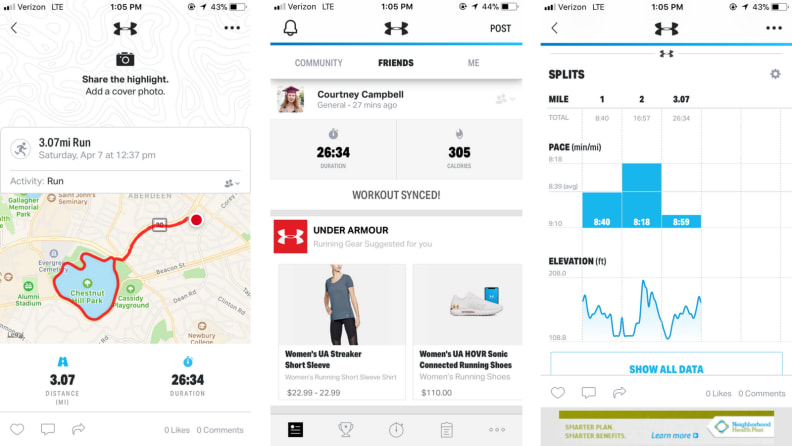
Screenshots of my May My Run, run.
My favorite feature: Pre-determined running routes.
There wasn’t anything too crazy about Map My Run. It tracks your basic stats, breaks your run into smaller courses, and compares runs against each other. The design initially feels clean, but there are ad bars that got in the way and were easy to accidentally click. However, you can also sync this app with Under Armour smart shoes and devices, which is definitely a plus if you own them.
With an account, you’re able to go to their website to plan out running loops in advance—a great feature I love using anyway, even if I don’t plan on running with their app. There’s even a feature called “Route Genius” that maps out a loop in your area after you provide a specific mileage. For training plans and greater insights, you’re going to need to upgrade to the MVP plan ($5.99/month or $29.99/year).
4. Strava
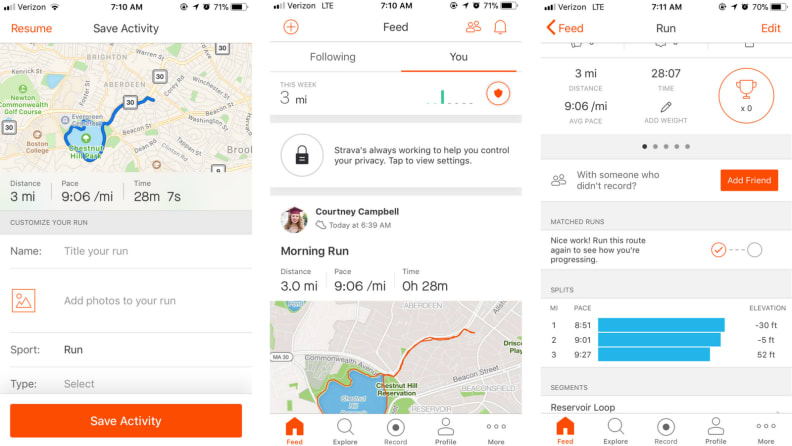
Screenshots of my Strava run.
My favorite feature: A social network for runners.
Stava is basically a social network for athletes. You’re able to track your bike ride or run and share it with friends alongside notes of how you felt or specific training you did—so you basically get to low-key brag about your progress. I do like the idea of challenges and connecting with friends, but I’d rather keep my data more personal and challenge myself, rather than make it a competition with other people.
The interface is pretty clean, but I did have some initial issues finding my splits post-run. Audio stats were read every 0.5 miles, which was way too frequent for me, and it didn’t include the last 0.05 miles on my run (which is important). The Premium version gives you plenty of perks like Beacon, which allows people to watch you on your run (not creepy?) and gives you a more in-depth look at your data ($7.99/month or 12 months for $30).
5. Runtastic
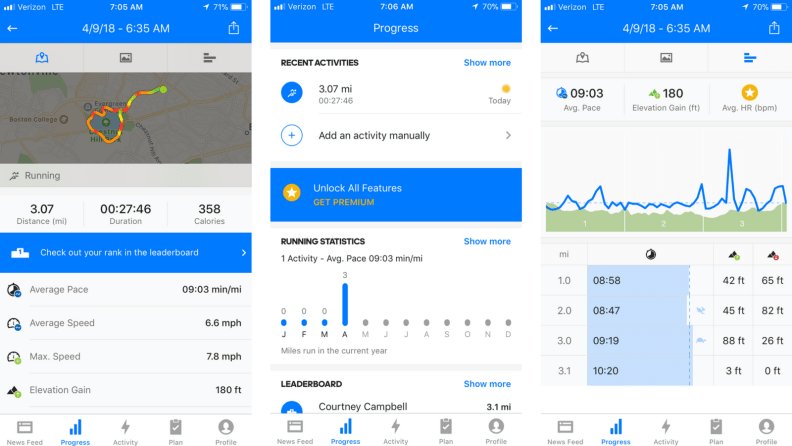
Screenshots of my Runtastic run.
My favorite feature: Gives you a good amount of stats. Runtastic was probably the most basic of all the apps. Its interface was easiest to use but not the most aesthetically pleasing, and like Map My Run there are a few ads that tend to get in the way. The two things that irritated me the most about this app were that it had a long countdown before starting (15 seconds) and I could barely understand the voice reading out my stats. To end the run, I had to slide my finger across the screen, which was honestly kind of difficult with sweaty fingers. Runtastic gives you a good amount of stats but makes you pay for things like training plans and routes with Premium ($9.99/month or $35.99/year), which other apps offer for free.
6. WeaveRun
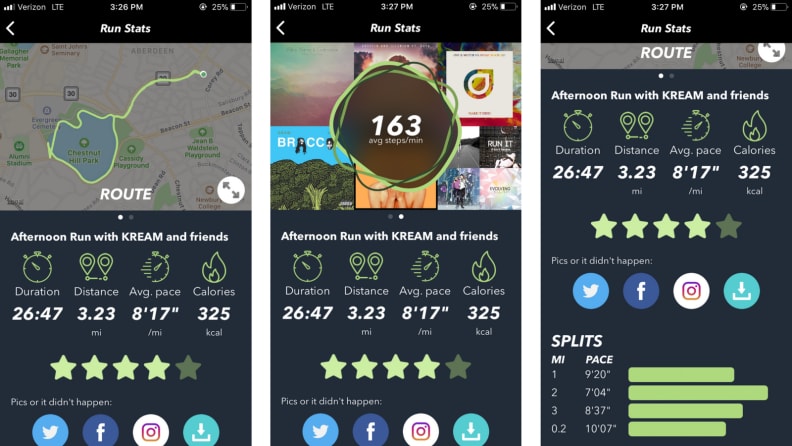
Screenshots of my WeaveRun app. Notice the extra distance tagged on.
My favorite feature: Amazing playlist options that make the run more enjoyable.
The whole idea behind WeaveRun, available for iOS only, is to have your music sync up to the cadence your running at (mine's about 160 steps/minute), encouraging you to run faster. And honestly, it worked. I chose one of the nighttime playlists while using the app and it felt I was at an EDM concert—in a good way. My feet were literally hitting the ground to the beat of the music, which felt crazy. I probably had my most enjoyable run where I didn’t feel like stopping while using this app.
The big glaring issue with WeaveRun is that it’s not accurate. It tacked on an extra 0.2 miles to my run somehow, which lowered my overall mile time. I made me feel good for a moment, but it’s not great for seeing any progress. It also gives you the fewest amount of stats of all the apps and you can’t listen to your own music, though I would gladly listen to one of their playlists while using another app if I could.
